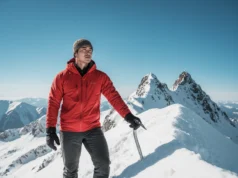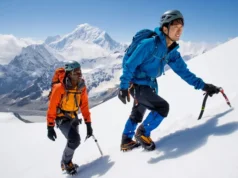In this article
You’re standing at a trail junction, a challenging peak looming ahead. The trail guide in your hand reads, “the route becomes Class 3 after the saddle.” What does that really mean? Is it just hard hiking, or something more? For years, I’ve watched aspiring adventurers pause at signs just like this, a mix of ambition and uncertainty on their faces. This guide is your translator. It will transform the cryptic numbers and letters of the Yosemite Decimal System (YDS) into a clear language of the land, empowering you to read the terrain, understand the consequences, and turn your knowledge into a wilderness instinct that keeps you safe on every adventure, from simple hiking to serious mountaineering.
Together, we’ll walk through the hiker’s spectrum, focusing on that critical transition from walking on a trail (Class 1-2) to using your hands on the rock (Class 3-4). We’ll unpack why the “consequence of a fall” is the single most important concept to grasp and how a simple “downclimbing test” can save your life. We’ll go beyond that single number to decode the full rating, giving you a complete picture of a route’s seriousness. Finally, we’ll take this theory to the trail, looking at real-world examples that will prepare you for a safe progression to scrambling.
What is the Yosemite Decimal System (YDS)?
At its heart, the Yosemite Decimal System is a five-part grading system used for rating the difficulty of terrain. It’s the standard rating system in North America for a wide range of activities, including hiking, scrambling, and technical rock climbing. Think of it not as a simple grade, but as a detailed story about the challenge ahead, where the final rating is often based on the difficulty of the single hardest section, or the crux.
What are the five main components of a YDS rating?
The story begins with the Class (1-5), the first and most fundamental component. This number describes the type of movement required, from simple trail walking to advanced technical rock climbing. This primary distinction separates hiking from scrambling and scrambling from the various disciplines of climbing.
For free climbing, which begins at Class 5, the Decimal Grade (5.0-5.15) adds a layer of precision, quantifying the sheer physical difficulty of the moves. Below 5th Class, this decimal is irrelevant. What is highly relevant, especially for evaluating risk on serious scrambles and traditional climbing routes, is the Safety/Protection Rating (G, PG, PG-13, R, X). This letter grade assesses the potential consequences of a fall based on the quality of available protection.
To complete the picture, two final components add context. The Commitment Grade (I-VI), a Roman numeral, indicates the overall time and seriousness of the route, from a few hours to a multi-day ascent on a massive wall like El Capitan. Lastly, there’s the Aid Rating (A0-A6/C0-C5), a separate scale used only for aid climbing, where climbers pull on gear to make upward progress. For hikers and scramblers, understanding Classes 1 through 4 is the master key. A full rating like “5.9 R, Grade IV” is a complete code, telling a rich story about the physical moves, the risk, and the length of the day.
This system, now the standard for assessing UIAA scales of difficulty across North America, didn’t appear overnight. Its story begins not on a vertical cliff face, but on the hiking trails of the High Sierra, evolving to define an activity between hiking and rock climbing we now call scrambling.
Why Was the YDS Created? From Hiking Trails to El Capitan
The language of the YDS wasn’t born in the rarified air of elite climbing; its origin/history is firmly planted in the soil of hiking trails. To understand the system is to understand its evolution from the original Sierra Club grading system.
How did a system for hikers evolve to grade the world’s hardest climbs?
Our story begins with the Sierra Club in the 1930s. As members explored the vast Sierra Nevada, they needed a simple way to classify the difficulty of their outings. This early system established the “Class” concept to differentiate between on-trail walking and more demanding off-trail terrain.
Fast forward to the 1950s at Tahquitz and Suicide Rocks in Southern California, a crucible of American rock climbing. Climbers there, including pioneers like Royal Robbins, faced a new problem. Their hardest rating was “Class 5,” but it was a bucket so large it had become meaningless. To solve this, they created the decimal subdivision—5.0, 5.1, 5.2—to add much-needed precision to fifth class climbing.
Originally, this was a “closed scale,” capped at 5.9. But as climbers continued to push boundaries, the system was forced to become an open-ended scale. This has led to the addition of letter subgrades (a-d) for routes 5.10 and harder, accommodating today’s most difficult climbs, like those established by elites such as Adam Ondra, Chris Sharma, and Tommy Caldwell. This history perfectly parallels a hiker’s own journey of progression: we start on simple trails and gradually take on more challenging objectives as our skills develop.
What is the Real Difference Between Hiking, Scrambling, and Simple Climbing?
This is where theory meets the trail. The structure/subdivisions between Classes 2, 3, and 4 can seem blurry in a guidebook, but on a steep mountainside, they are crystal clear. This trail difficulty assessment is the most important skill in the hiker-to-scrambler transition guide.
How do I distinguish Class 2, Class 3, and Class 4 terrain?
Let’s break it down by movement and, more importantly, by consequence.
Class 1 (Trail Walking): This is simply walking on a well-established trail.
Class 2 (Off-Trail Hiking): This is simple scrambling with occasional use of hands for balance. Imagine hiking on an unmaintained trail or crossing a field of boulders. The movement is still primarily walking. If you slip, the consequence is low.
Class 3 (Scrambling): This is the key transition where hands are now required for continuous upward movement. The terrain is often steep, but holds are plentiful. A fall could be dangerous and result in serious injury, but is not necessarily fatal. An experienced scrambler generally does not require a rope.
- The Litmus Test for Class 3: “Most people can comfortably downclimb it facing outward.”
Class 4 (Simple Climbing): This is not “hard scrambling”; it is simple climbing with significant exposure. A rope is often used for belaying partners or to rappel descents, which requires knowledge of basic ropework and knots. An unroped ascent of Class 4 terrain is a form of free-soloing and extremely dangerous.
| The Hiker & Scrambler’s YDS (Classes 1-4) | |||
|---|---|---|---|
| Class | Name | Movement | Consequence |
| 1 | Trail Walking | This is simply walking on a well-established trail. | Minimal risk; falls are rare and result in no serious injury. |
| 2 | Off-Trail Hiking | This is simple scrambling with occasional use of hands for balance. Imagine hiking on an unmaintained trail or crossing a field of boulders. The movement is still primarily walking. | Low risk; if you slip, consequences are minor, such as a sprained ankle or scraped knee. Falls are unlikely due to moderate terrain. |
| 3 | Scrambling | Hands are used continuously for upward progress. Holds are plentiful and easy to grip, though the terrain may be steep. Scrambling with both hands and feet; selecting and testing holds. | Moderate exposure; if you slip, potential for serious injury like broken bones due to steepness and reliance on handholds. |
| 4 | Hard Scrambling / Easy Climbing | Hands are used continuously for upward movement, with terrain sometimes approaching vertical. Holds are abundant and reliable, but difficulty lies in sustained use of handholds. Sustained scrambling or easy climbing. | Higher exposure; if you slip, high risk of severe or fatal injury due to near-vertical nature and significant drops. Rope use advisable. |
- The Litmus Test for Class 4: “Most people feel the need to downclimb it facing inward,” maintaining three points of contact.
- The Consequence of a Fall (Class 4): This is the most important attribute. A fall is likely to be fatal. Exposure—the psychological and physical risk associated with a long fall—is often the defining factor. It’s crucial to remember the limitations/oversimplification of any grading system; your personal risk assessment is paramount.
Pro-Tip: The line between a hard Class 3 and an easy Class 4 can feel subjective. If you find yourself hesitating, ask this question: “If I slipped right here, what would happen?” If the answer is anything other than “I’d slide a bit and get some scrapes,” it’s time to treat the terrain with the seriousness of Class 4. Your risk assessment should always trump the guidebook rating.
These definitions, and the field-tested standards for rock scrambling they’re based on, can feel abstract. Let’s make them tangible. On this kind of terrain, your Essential gear expands beyond comfort to include items for survival.
Case Study 1: The Class 3 Longs Peak “Keyhole Route”
The Longs Peak Keyhole Route in Rocky Mountain National Park is a classic Class 3 scramble, similar in nature to other Colorado routes like the Mt. Evans The Sawtooth traverse. After the Keyhole, the route traverses The Ledges, then ascends The Trough, a long gully requiring continuous hand-and-foot climbing. The infamous Narrows serves as the mental crux for many due to exposure, but the passage is secure. A fall would be very serious, fitting the Class 3 definition perfectly. Thousands complete this route annually without ropes, but it demands respect, fitness, and stable weather.
Case Study 2: The Class 4 Capitol Peak “Knife Edge”
The Knife Edge on Capitol Peak is the quintessential Class 4 route, where exposure, not technical difficulty, defines the challenge. It is as serious as other formidable Class 4s like the Pyramid Peak Northeast Ridge. The Knife Edge is a 150-foot-long ridge with 2,000-foot drops on both sides. The rock quality is generally solid, and the holds are good, but a fall would be fatal. This perfectly illustrates the Class 4 definition. The leap from Class 4 to Class 5 marks the transition to technical disciplines like sport climbing, traditional climbing, and multi-pitch routes, where belaying is a mandatory part of the safety system.
How Does the Full YDS Rating System Work?
You’ve now mastered the most important part of the YDS for any hiker or scrambler. To complete your journey to fluency, let’s look at the other components that provide a full, holistic picture of the adventure’s route complexity.
What do the Protection and Commitment ratings mean?
The safety/protection ratings (G, PG, PG-13, R, X), introduced by Jim Erickson for traditional climbing, add a crucial layer of risk assessment.
- G (Good): Solid, plentiful protection.
- PG (Pretty Good): Adequate protection.
- PG-13: Protection may be sparse, with long fall potential.
- R (Runout): Protection is poor. A fall from difficult sections will likely result in serious injury.
- X (Extreme): No protection. A fall is likely to be fatal. An X-rated climb is extremely serious.
The Commitment Grade (I-VI) tells you about the length and seriousness of the day, a critical factor in alpine climbing. A Grade III route is a long, full-day affair. Reading them together—”Class 3, Grade IV”—tells you the scrambling is moderate but the day is very long and serious.
It is critical to acknowledge the subjectivity/variations inherent in any grading system. A grade is a community consensus validation, not an objective fact. You will encounter terms describing this regional bias. A route might be called “sandbagged” or have an “old school rating” if it feels much harder than the grade suggests (common in areas like J-Tree), while a “soft climb” feels easier.
Pro-Tip: Use the Commitment Grade to plan your logistics. A Grade I or II might be an afternoon outing. For a Grade III, you’re packing a headlamp and extra food, no questions asked. For a Grade IV or higher, you’re not just planning the day; you’re planning for a potential unplanned night out. It dictates your gear, your start time, and your mindset.
With this complete code, you can now understand the full scope of an adventure. Understanding the seriousness of a route directly relates to preparedness, and The Ten Essentials are a foundational safety system every hiker must carry.
Conclusion
The Yosemite Decimal System is the standard grading system in North America that rates terrain type, technical difficulty, risk, and commitment. The critical difference between Class 3 and Class 4 is the consequence of a fall, best determined by the “downclimbing test.” We’ve learned that “exposure” is often more important than technical difficulty. Reading the full YDS code allows you to assess the total risk of an objective before leaving the trailhead. You now have the tools to translate the YDS from a set of numbers into a clear story. Use this knowledge to choose your next challenge wisely, and share what you’ve learned to keep everyone safe on the trail.
Frequently Asked Questions about the Yosemite Decimal System
What is the real difference between Class 2, Class 3, and Class 4?
The primary difference lies in the use of hands and the consequence of a fall. Class 2 requires occasional hand use for balance, Class 3 requires continuous hand use for upward movement (scrambling), and Class 4 is simple climbing where a fall could be fatal.
What does exposure mean in hiking and scrambling?
Exposure refers to the high risk of injury from a fall due to the steepness of the terrain. It is the feeling of empty space below you and is the key factor that makes Class 4 terrain so serious.
What gear do I need for a Class 3 scramble?
Essential gear selection includes sturdy boots for class 3 terrain (or approach shoes with sticky rubber), a helmet if there is rockfall danger, and a pack with navigation and the Ten Essentials. Always practice Leave No Trace principles. While a rope is not typically necessary, some parties may carry one.
How does the YDS for hiking or scrambling compare to bouldering grades (V-Scale)?
The two systems do not convert well. The Sherman V-grade system (or V-scale) measures a few moves of maximal, powerful difficulty. The YDS measures the risk of an entire, sustained route, factoring in endurance and the pump factor. While you can find a grade comparison chart online, any conversion chart offering international conversions should be seen as a rough guideline due to factors like indoor vs. outdoor difficulty and climbing style.
Risk Disclaimer: Hiking, trekking, backpacking, and all related outdoor activities involve inherent risks which may result in serious injury, illness, or death. The information provided on The Hiking Tribe is for educational and informational purposes only. While we strive for accuracy, information on trails, gear, techniques, and safety is not a substitute for your own best judgment and thorough preparation. Trail conditions, weather, and other environmental factors change rapidly and may differ from what is described on this site. Always check with official sources like park services for the most current alerts and conditions. Never undertake a hike beyond your abilities and always be prepared for the unexpected. By using this website, you agree that you are solely responsible for your own safety. Any reliance you place on our content is strictly at your own risk, and you assume all liability for your actions and decisions in the outdoors. The Hiking Tribe and its authors will not be held liable for any injury, damage, or loss sustained in connection with the use of the information herein.
Affiliate Disclosure: We are a participant in the Amazon Services LLC Associates Program, an affiliate advertising program designed to provide a means for us to earn advertising fees by advertising and linking to Amazon.com. As an Amazon Associate, we earn from qualifying purchases. We also participate in other affiliate programs and may receive a commission on products purchased through our links, at no extra cost to you. Additional terms are found in the terms of service.





